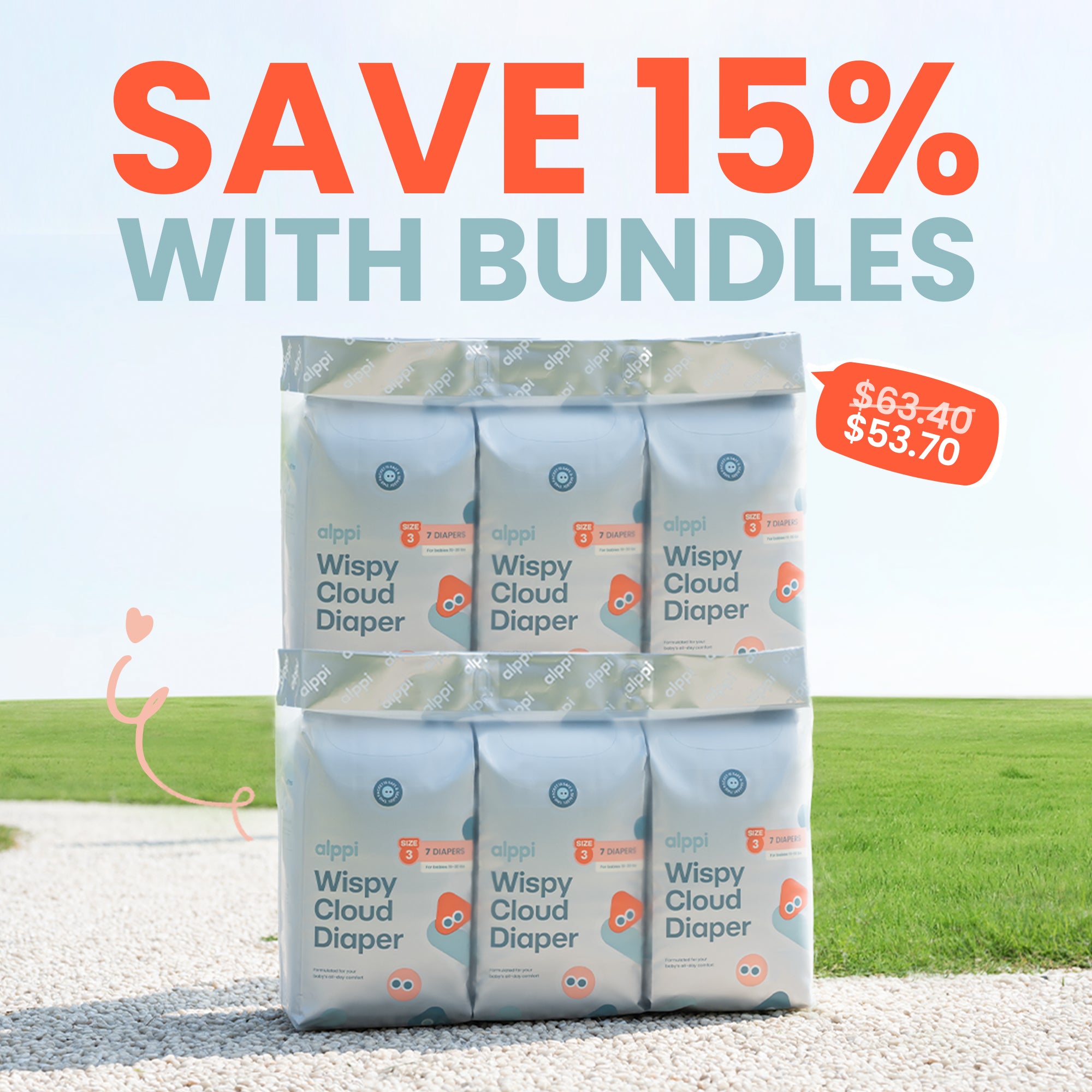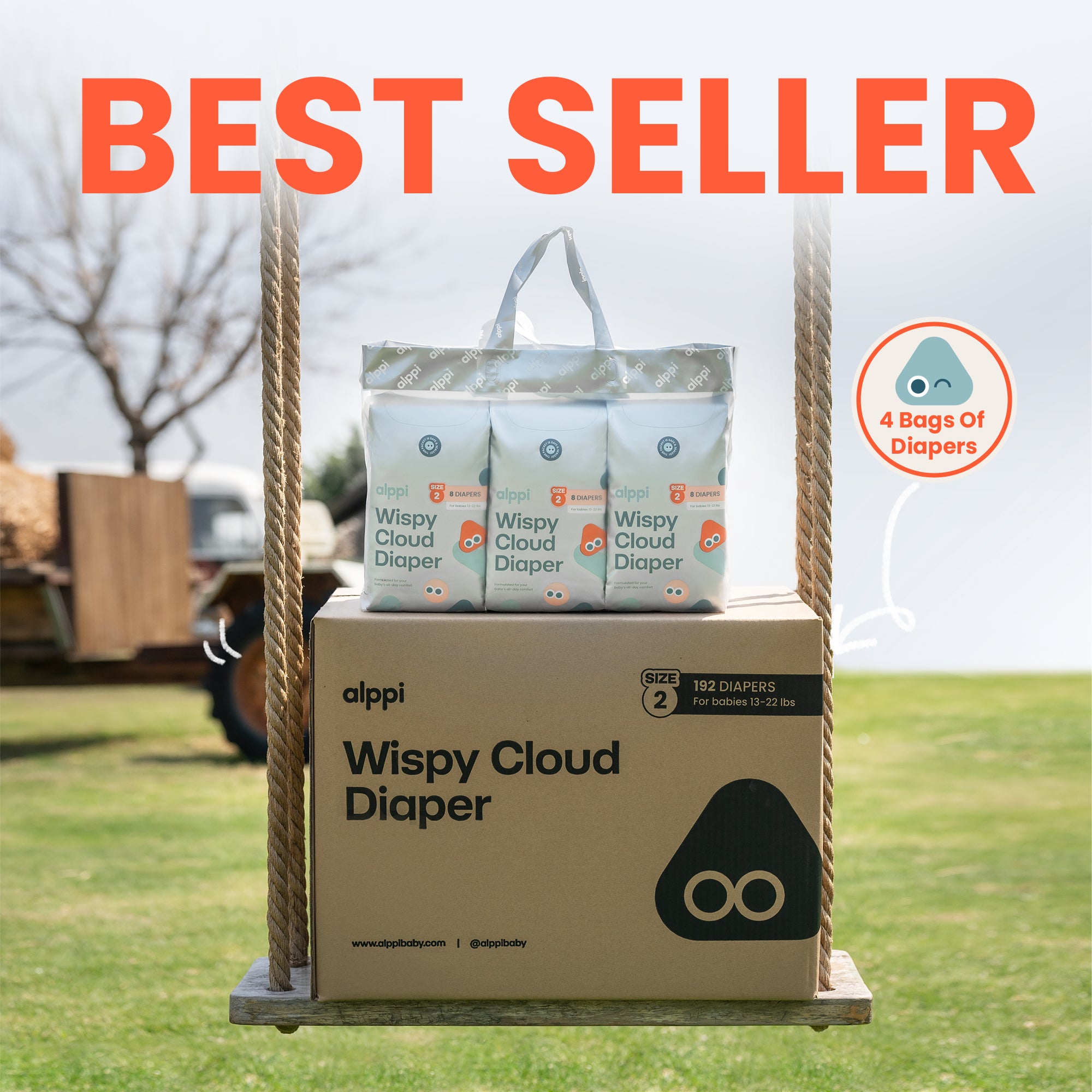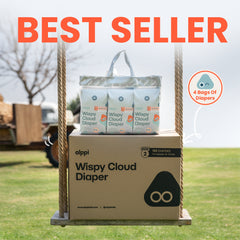Finding the best hypoallergenic diapers is a priority when your baby has sensitive skin. Red bumps, rashes, and restless nights are clear signs that not every diaper is gentle enough.
The challenge is that not all “sensitive” diapers are truly hypoallergenic. Some still contain chemicals or fragrances that can irritate delicate skin.
By knowing what to look for, you can choose diapers that are both safe and effective. The right option will keep your baby comfortable, dry, and free from irritation.
Looking for diapers that feel feather-light and gentle? Explore our Alppi Wispy Cloud Diapers designed for sensitive skin and all-day comfort.
What Makes The Best Hypoallergenic Diapers For Sensitive Skin

The best hypoallergenic diapers use safe, gentle materials and avoid harsh processing. They leave out common irritants like fragrances, dyes, and latex, while meeting dermatologist-tested safety standards.
Chemical-Free Materials That Won't Irritate Baby's Skin
Parents should look for diapers made with plant-derived, baby-safe materials that touch the skin directly. A good absorbent core often combines responsibly sourced wood pulp with safe polymers to keep babies dry without harsh chemicals.
The most reliable hypoallergenic diapers are free from parabens, phthalates, heavy metals, latex, and VOCs (volatile organic compounds). Every layer should be soft, breathable, and non-toxic.
Chlorine-Free Processing For Gentle Protection
Many conventional diapers use chlorine bleaching, which can leave behind unwanted residues. A better choice is Totally Chlorine-Free (TCF) processing, which uses oxygen-based methods to clean the pulp without creating harmful byproducts.
TCF also reduces environmental impact by cutting down on water pollution and chemical waste. Look for responsibly sourced pulp (such as FSC-certified) to ensure both safety and sustainability.
Fragrance-Free And Dye-Free Formulations
Fragrances and dyes are some of the most common culprits behind diaper-related rashes. Hypoallergenic diapers avoid these entirely, along with lotions, optical brighteners, and other unnecessary additives.
Simple, fragrance-free designs are generally best for sensitive skin. Wetness indicators can still be included, but should be made with baby-safe materials.
Dermatologist-Tested Safety Standards
Strong hypoallergenic options are dermatologist-tested to confirm they’re safe for delicate skin. This testing ensures diapers don’t disrupt skin pH, trap excess moisture, or introduce unnecessary irritants.
Some brands also test their products on babies with conditions like eczema to make sure they’re gentle enough for even the most sensitive skin types.
Not sure where to start? Check out our Staff Picks Collection to see the diapers parents and our team love most.
Other Features To Look For In Hypoallergenic Diapers
The best hypoallergenic diapers don’t just avoid allergens — they’re designed with comfort and skin health in mind. Features like breathable fabrics, gentle elastic, strong absorption, and latex-free construction all help protect sensitive skin.
Breathable Fabrics That Prevent Rashes and Overheating
Airflow is key for babies with delicate skin. Breathable outer covers let air circulate while locking moisture inside, reducing heat and humidity against the skin.
Look for breathable features such as:
- Micro-perforated outer covers
- Moisture-wicking inner liners
- Air-flow channels in the design
These features are especially helpful for overnight wear, when diapers stay on longer. A well-ventilated design keeps your baby’s skin drier and less prone to irritation.
Soft Elastic Waistbands That Won’t Leave Red Marks
Elastic should hold the diaper in place without digging into your baby’s skin. Gentle, stretchy materials around the waist and legs provide a secure but comfortable fit.
Key things to check:
- Wide waistbands that spread pressure evenly
- Soft-touch elastic that feels smooth against the skin
- Stretchy leg cuffs that move with your baby
If elastic feels stiff or leaves red marks, it’s too tight. Soft, flexible bands help prevent irritation as your baby grows and moves.
Superior Absorption Without Harsh Chemicals
Absorption is about more than dryness — it’s also about protecting sensitive skin. A safe absorbent core should pull moisture away quickly without relying on harsh treatments.
Safer absorption features include:
- Chlorine-free fluff pulp
- Baby-safe absorbent polymers
- Chemical-free odor control
A good wetness indicator can also help you change diapers before moisture lingers too long. Fast absorption plus safe materials keeps skin healthier and more comfortable.
Latex-Free Construction for Allergy Prevention
Latex is a common allergen and should never be in a hypoallergenic diaper. Even small amounts in waistbands or tabs can trigger reactions.
Always check these areas for latex:
- Waistband elastic
- Leg cuffs
- Adhesive tabs
Most quality hypoallergenic diapers are completely latex-free, giving you peace of mind that your baby’s skin won’t be exposed to unnecessary risks.
How To Choose The Right Hypoallergenic Diaper For Your Baby

Finding the best diapers for sensitive skin means paying attention to your baby’s unique needs and checking labels carefully. The right fit, safe ingredients, and a little trial and error can go a long way toward keeping skin calm and comfortable.
Identifying Your Baby’s Specific Skin Sensitivities
Every baby reacts differently, but there are common signs that point to diaper sensitivity:
- Red patches or bumps in the diaper area
- Dry, irritated skin that doesn’t improve with cream
- Rashes that appear after long wear or overnight
Typical triggers include:
- Synthetic fragrances
- Chlorine bleaching agents
- Latex in waistbands or cuffs
- Preservatives and parabens
- Harsh dyes or lotions
Keep a simple log of when rashes appear and which products you used. This helps you spot patterns, like reactions to certain wipes or warmer weather when skin gets more sensitive.
Reading Diaper Labels for Hidden Irritants
Ingredient lists can be tricky, but knowing what to avoid makes the search easier.
Avoid:
- Elemental chlorine (look for “chlorine-free” instead)
- Added fragrances or perfumes
- Phthalates and parabens
- Latex rubber
- Heavy metals in dyes
Look for:
- Chlorine-free wood pulp
- Plant-derived, baby-safe materials
- Hypoallergenic claims backed by testing
Tip: Fewer ingredients usually mean fewer chances for irritation. Words like “gentle” or “natural” don’t guarantee safety, so always check the fine print.
Testing New Diapers Safely
When trying a new diaper, start small and observe how your baby’s skin reacts.
Safe testing steps:
- Begin with a small pack before committing
- Try the diaper during the day so you can check often
- Inspect skin every 2–3 hours for redness or irritation
- Stop use immediately if you see a reaction
- Wait 24–48 hours before trying again
It’s best to test when your baby isn’t teething or sick, since those times can make skin extra sensitive. Keep a trusted barrier cream nearby to calm minor irritation quickly.
Finding the Perfect Size for Sensitive Skin Protection
A good fit is just as important as safe materials. Diapers that are too tight can leave red marks, while loose ones may leak and cause irritation.
Signs of correct fit:
- No red marks around waist or thighs
- Two fingers fit comfortably under the waistband
- Leg cuffs lie flat without gaps
- No exposed skin at the back or sides
Babies grow quickly, and sensitive skin often does better in a slightly roomier size. If rashes or leaks keep happening, it may be time to size up sooner than expected.
Want extra peace of mind for your little one’s skin? Discover our Safety Page Collection with hypoallergenic, fragrance-free, and chlorine-free diapers.
Conclusion: Best Hypoallergenic Diapers
Choosing the best hypoallergenic diapers comes down to safe materials, gentle design, and the right fit for your baby’s sensitive skin. By focusing on what truly matters—fragrance-free, chlorine-free, and latex-free options—you can help prevent irritation and keep your little one comfortable.
Remember, every baby is different. Paying attention to their skin’s signals will guide you toward the diapers that work best for them.
Want to learn more about why chlorine-free diapers make such a difference? Read our next article: Why Chlorine-Free Diapers Matter.
Frequently Asked Questions: Best Hypoallergenic Diapers
What diapers do dermatologists recommend?
Dermatologists recommend diapers without fragrances, dyes, or harsh chemicals. Hypoallergenic and dermatologist-tested options are safest for sensitive skin. Choosing gentle, simple designs helps reduce irritation.
Which diapers have no rash?
No diaper can guarantee a baby will never get a rash. Fragrance-free and chlorine-free diapers lower the risk of irritation. Frequent changes are the most effective prevention.
What is the healthiest brand of diapers?
The healthiest diapers avoid chlorine, fragrances, dyes, and latex. These features help protect delicate, sensitive skin. Always check labels to confirm what’s inside.
What do pediatricians recommend for diaper rash?
Pediatricians recommend changing diapers often to keep skin dry. Breathable, hypoallergenic diapers with wetness indicators can make this easier. If rashes continue, a pediatrician should be consulted.













